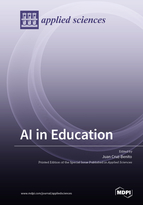AI in Education
A special issue of Applied Sciences (ISSN 2076-3417). This special issue belongs to the section "Computing and Artificial Intelligence".
Deadline for manuscript submissions: closed (25 February 2022) | Viewed by 22625
Special Issue Editor
Interests: human-computer interaction; machine learning; data science; education
Special Issues, Collections and Topics in MDPI journals
Special Issue Information
Dear Colleagues,
Artificial Intelligence (AI) is changing the world as we know it. Recent advances are enabling people, companies, and governments to envision and experiment with new methods of interacting with computers and modifying how virtual and physical processes are carried out. One of the fields in which this transformation is taking place is education. After years of witnessing the incorporation of technological innovations into learning/teaching processes, we can currently observe many new research works involving AI. Moreover, there has been increasing interest in this research area after the COVID-19 pandemic, driven towards fostering digital education.
Among recent research in this field, AI applications have been applied to enhance educational experiences, studies have considered the interaction between AI and humans while learning, analyses of educational data have been conducted, including machine learning techniques, and proposals have been presented for new paradigms mediated by intelligent agents.
This Special Issue, entitled "AI in Education", aims to reflect recent research in the field of AI and education. These works can present new advances in methods, applications, and procedures to enhance educational processes via artificial intelligence and its subfields (machine learning, neural networks, deep learning, cognitive computing, natural language processing, computer vision, etc.).
We expect submissions focused on both the theoretical aspects and applications of AI and its subfields in education. New ideas proposing novel approaches are also welcome.
Topics of interest include, but are not limited to, the following areas:
- Human–computer interactions in aspects of AI in education;
- New teaching/learning paradigms through the inclusion of AI in education;
- Multimodal applications of AI in education;
- New applications of AI, ML, DL, etc., in teaching/learning;
- AI-based assessment of learning.
We hope that this Special Issue will allow researchers to reflect on the application of AI in education and propose new ways to enhance teaching/learning experiences.
Dr. Juan Cruz-Benito
Guest Editor
Manuscript Submission Information
Manuscripts should be submitted online at www.mdpi.com by registering and logging in to this website. Once you are registered, click here to go to the submission form. Manuscripts can be submitted until the deadline. All submissions that pass pre-check are peer-reviewed. Accepted papers will be published continuously in the journal (as soon as accepted) and will be listed together on the special issue website. Research articles, review articles as well as short communications are invited. For planned papers, a title and short abstract (about 100 words) can be sent to the Editorial Office for announcement on this website.
Submitted manuscripts should not have been published previously, nor be under consideration for publication elsewhere (except conference proceedings papers). All manuscripts are thoroughly refereed through a single-blind peer-review process. A guide for authors and other relevant information for submission of manuscripts is available on the Instructions for Authors page. Applied Sciences is an international peer-reviewed open access semimonthly journal published by MDPI.
Please visit the Instructions for Authors page before submitting a manuscript. The Article Processing Charge (APC) for publication in this open access journal is 2400 CHF (Swiss Francs). Submitted papers should be well formatted and use good English. Authors may use MDPI's English editing service prior to publication or during author revisions.
Keywords
- education
- educational assessment
- artificial intelligence
- machine learning
- natural language processing
- deep learning
- computer vision






